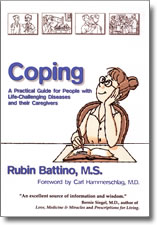| Home | Psychotherapy Vita |
Psychotherapy Workshops |
Chemistry Vita |
Chemistry Presentations |
Books |
COPING
A Practical Guide for People
with Life-Challenging Diseases
and Their Caregivers

by Rubin
Battino
M.S., Mental Health Counseling
Adjunct Professor
Department of Human Services (Counseling)
Wright State University
Illustrations by Mario Uribe
Copyright ©2000, Rubin Battino
Table of Contents
Preface
Contributors
Chapter 1. Introduction
1.1 Introduction1.2 Disease/Cure and Illness/Healing
1.3 Complementary and Nontraditional Approaches; Alternative Medicine and Therapies
1.4 David Spiegel’s Research
1.5 Summary
Chapter 2. Relaxation Methods
2.1 Introduction2.1 Jacobson’s Progressive Relaxation
2.3 Benson’s Relaxation Response Method
2.4 Meditation
2.5 How to Relax
2.6 Relaxation Script
2.7 Healing Presence Imagery Script
2.8 Healing Light Imagery Script
2.9 Healing Hands Imagery Script
2.10 Summary
Chapter 3. Support Groups
3.1 Introduction3.2 David Spiegel’s Breast Cancer Support Groups
3.3 Exceptional Cancer Patient (ECaP) Groups
3.4 The Charlie Brown Exceptional Patient Support Group (Dayton)
3.5 Residential and other Support Groups
Chapter 4. Journalling/Structured Writing/Videotaping/Art Therapy/Ceremonies
4.1 Introduction4.2 Journalling
4.3 Structured Writing — A Workbook For People Who Have Cancer or Other Life-Challenging Disease
4.4 Structured Writing — A Workbook For Grieving
4.5 Structured Writing — A Workbook For Care-Givers
4.6 Videotaping and Autobiographies
4.7 Art Therapy
4.8 Cancer or Other Serious Disease as a Gift
4.9 Rituals and Ceremonies
Chapter 5. Varieties of Coping
5.1 Introduction5.2 LeShan on How to Survive in a Hospital
5.3 Milstein’s Coping Suggestions and Comments
5.4 Communicating With Medical Personnel
5.5 Helplessness, Hopelessness, and Control
5.6 “Mechanical” Matters, Wills, etc.
5.7 Communicating With Others — Relationships
5.8 Support Networks
5.9 Counseling and Psychotherapy
5.10 Prayer and Religious Support
5.11 Helping Others
5.12 Massage
5.13 Information Sources
5.14 Controlling Medication
5.15 Pain Management
5.16 Nutrition
5.17 Physical Exercise
5.18 Acupuncture
5.19 Hypnosis
5.20 Talking To A Comatose Patient
5.21 Grieving
5.22 Meditation and Relaxation
5.23 Ideomotor Signaling
5.24 Simplicity
5.25 Laughter
5.26 Dying Well
5.28 Doka’s Phases of a Life-Challenging Disease
5.29 Hammerschlag’s Recommendations
5.30 Summary
Chapter 6. Nutrition and Life-Challenging Diseases
6.1 Introduction: Lifestyle and an Integrated Approach6.2 Prevention
6.3 Nutrition for Controlling or Curing a Disease
6.4 Summary
Chapter 7. Beyond Coping
Appendix A: Questions for People in Their Dying TimeAppendix B: Some Relevant Web Sites and Phone Numbers
Appendix C: Patient’s Bill of Rights
Appendix D: The Wellness Community Patient/Oncologist Statement
Appendix E: Living Will Declaration (State of Ohio)
Appendix H: Durable Power of Attorney for Health Care (Ohio)
Appendix F: Christian Affirmation of Life
Appendix G: The Christian Living Will
References
From the Foreword by Carl A. Hammerschlag, M.D.:
This is a guide for making connections with people facing serious illness and for those who care for them. It is a practical handbook that uses symbols, ceremonies and science to help people confront their realities and gain new perspectives in dealing with them. It will prepare the mind, body and spirit to face life challenges.
This is a book about healing and not curing, about coming to every day as if it has something to teach us. I encourage you to use the material in this book and customize it in ways that make sense to you. You can share it or send it to friends. It is intended as a gift, and if it works, let Rubin know how you’ve used it. The bibliography and websites are also useful references that will promote joy on your healing journey.
Comment by Bernie Siegel, M.D.:
An excellent source of information and wisdom.
| SITE DESIGN BY BATMOSPHERE | ⤒ |